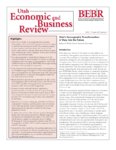TO
1 - 25 of 9
| Title | Date | Subject | Description | ||
|---|---|---|---|---|---|
| 1 |
 |
Biofuels--snake oil for the twenty-first century | 2008-12-01 | Most Americans are painfully aware that our present consumption of petroleum is unsustainable. The United States has less than 5% of the world's population, but consumes 24.4% of the world's petroleum production. Only 8.5% of the world's petroleum production comes from American wells, which necessit... | |
| 2 |
 |
State and regional control of geological carbon sequestration (Part I) | 2011-05 | state and regional control; geological carbon sequestration; hydrocarbon fuel; carbon capture; geologic sequestration | In the near future the use of coal may be legally restricted due to concerns over the effects of its combustion on atmospheric carbon dioxide concentrations. Carbon capture and geologic sequestration offer one method to reduce carbon emissions from coal and other hydrocarbon fuel. While the federal ... |
| 3 |
 |
Fine particle emissions from residual fuel oil combustion: Characterization and mechanisms of formation | 2000 | fine particle emissions; residual fuel oil combustion; airborne fine particulate matter (PM); particulate characteristics of PM | The characteristics of particulate matter (PM) emitted from residual fuel oil combustion in two types of combustion equipment were compared. A small commercial 732 kW rated fire-tube boiler yielded a weakly bimodal particulate size distribution (PSD) with over 99% of the mass contained in a broad co... |
| 4 |
 |
Immigrants transform Utah: entering a new era of diversity | 2004-05 | Utah is generally perceived as an extremely homogeneous state whose population can trace its ancestry mostly to northern Europe. Listings for surnames like Hansen, Jensen, and Christensen do fill many pages in local telephone directories throughout the state. According to census counts, the minority... | |
| 5 |
 |
Utah's demographic transformation: a view into the future | 2008 | Utah, along with the rest of the nation, is in the midst of an extraordinary demographic transformation which has far from run its course. The confluence of four major trends continues to dramatically reshape the size and composition of the national and state populations. These trends include the ar... | |
| 6 |
 |
Control of geological carbon sequestration in the western United States | 2011-05 | coal; carbon dioxide; electric utilities; carbon sequestration; sequestration; geological sequestration; climate change | In the near future, the use of coal may be legally restricted due to concerns over the effects of its combustion on atmospheric carbon dioxide concentrations. Carbon capture and geologic sequestration offer one method to reduce carbon emissions from coal and other hydrocarbon fuel. While the federal... |
| 7 |
 |
Revised Utah population estimates for the 1990s | 2001-05 | Every 10 years, the U.S. Bureau of the Census conducts a population count. In the intervening years the Utah Population Es timates Committee (UPEC) annually prepares total resident population estimates for each of the 29 counties in the state. These estimates are based on methods that ut i l i z e s... | |
| 8 |
 |
Water for commercial oil shale development in Utah: Allocating scarce resources and the search for new sources of supply | 2010 | commercial oil shale development; allocating resources; oil shale; bitumen | BACKGROUND A. What Is Oil Shale and Why Do We Care? Oil shale is a sedimentary rock containing solid bituminous materials. When oil shale is heated, petroleum-like liquids and gasses are released. The process of heating shale and capturing resulting liquids and gasses is called retorting and can occ... |
| 9 |
 |
Federal control of carbon capture and storage | 2011-09 | carbon capture; carbon storage; coal; carbon sequestration | The United States has economically recoverable coal reserves of about 261 billion tons, which is in excess of a 250-year supply based on 2009 consumption rates. However, in the near future, the use of coal may be legally restricted because of concerns over the effects of its combustion on atmospheri... |
1 - 25 of 9
